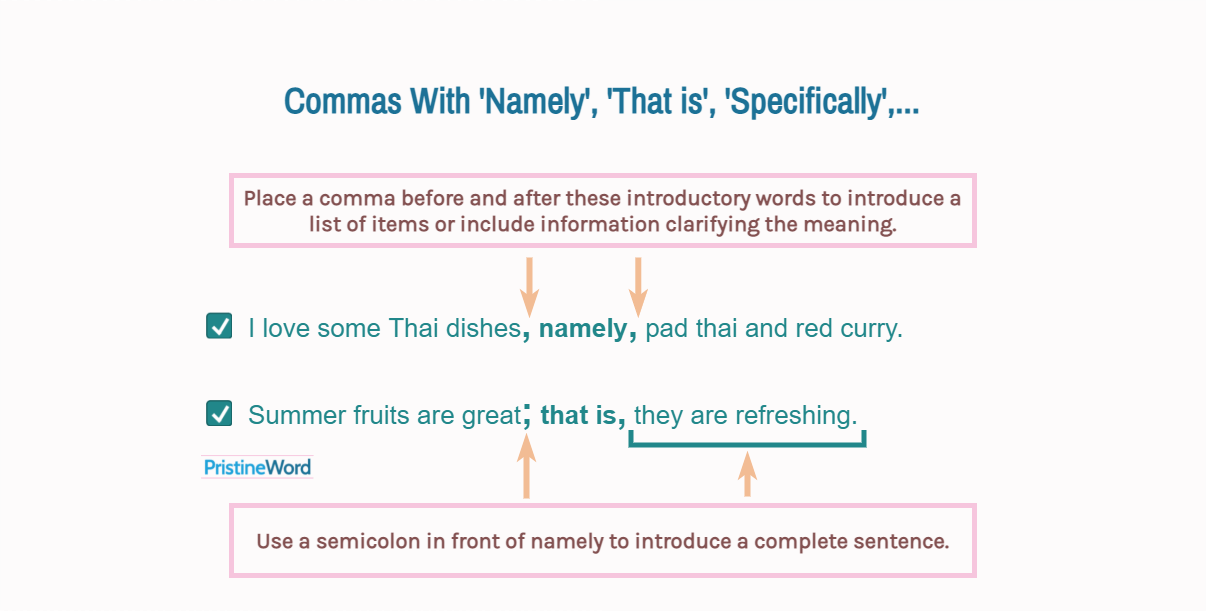Place a comma before and after namely, that is, and specifically to introduce a list of items or include information that clarifies the meaning of a sentence.
Place a comma before and after namely, that is, and specifically to introduce a list of items or include information that clarifies the meaning of a sentence.
I love some Thai dishes, namely, Pad Thai, noodle soup, and red curry.
I love some Thai dishes namely Pad Thai, noodle soup, and red curry.
Use a semicolon in front of namely and its synonyms to introduce a complete sentence.
I love some Thai dishes; namely, pad thai and red curry are delicious.
Namely, that is, specifically, or more precisely can be preceded by an em dash (—) or an open parenthesis to clarify the meaning of the sentence or indicate an interruption.
The new law will have an impact on light weapons—namely, shotguns and rifles.
I love some dark colors (namely, brown and dark blue).
Contents
1. Punctuation Marks with 'Namely' and Synonyms
We can use connectors such as namely to give further details about something we have just said. They should be preceded and followed by commas because they interrupt the sentence flow, or add extra information without changing the basic meaning of a thought.(1)
I would like to acquire new tech skills, namely, programming and data analysis.
Follow similar punctuation rules when using "in other words", that is, that is to say, specifically, more precisely, more specifically, etc. These connectors are synonyms of namely and interchangeable in many situations.
There are two skills that graduate recruiters want, that is, leadership and teamwork.
I need to buy some groceries, specifically, rice, pasta, and canned fruit.
Use semicolons to introduce a complete sentence (a set of words that contain a subject and a verb) after namely, that is, etc.
Summer fruits are great; that is, they are refreshing and healthy.
I am learning Spanish; namely, I'd like to speak to Spanish customers by phone.
Use parentheses to enclose information that clarifies or is used as an aside.
I need to buy a new computer (specifically, a laptop computer with a solid battery life).
I love Italian dishes (namely, pizza and lasagna).
Add an em dash before namely, that is, specifically, etc. to indicate an interruption or add emphasis.
I would like to visit Italy—more precisely, Lazio, Lombardy, and Veneto.
We need a new organizational structure—namely, a more productive system.
To eliminate redundancies, avoid using a colon ":" after these introductory words. A colon means "that is to say"(1), so there is no need to use it along with namely, that is, specifically, etc.
I love some Asian countries, namely: Thailand and Vietnam.
I love some Asian countries, namely, Thailand and Vietnam.
The abbreviation "i.e." means "that is". Both words have the same meaning and are used in the same way, so follow the same strategy regarding the use of commas with i.e.
Recommended: Commas and conjunctive adverbs
2. More Examples
- The CEO of the company, that is, the big boss, keeps making us work harder and harder.
- You need to learn the three most spoken languages in the world, namely, English, Chinese, and Spanish.
- Some computers, namely, old desktop computers, slow down when having many programs running.
- The development of new theories and laws in physics, more precisely, general relativity and quantum mechanics, led to the development of nuclear weapons.
- I want you to start working on self-improvement; specifically, you could wake up early, level up your skills, and read every day.
- Somalia is one of the most dangerous countries in the world; more specifically, there is a high risk of terrorist attack and kidnapping.
- There are many things I love about Christmas, namely, listening to Christmas carols, buying gifts for your loved ones, and vacation time.
- Olivia is looking for a new job, more precisely, she wants to work as a software development engineer.
- I love some summer fruits, specifically, watermelon and cherries.
- This word is important; that is, you cannot remove it without changing the meaning of your sentence.
3. Conclusion
Follow these guidelines to punctuate correctly the introductory words and phrases namely, that is, specifically, more precisely, etc.
- Enclose these words in commas when introducing a series of terms or adding extra information.
- Place a semicolon in front of namely, that is, specifically, more precisely, etc. when introducing a complete sentence.
- With these words, you can also use parentheses to add information or an em dash to indicate an interruption. Remember that these punctuation marks replace the use of commas.
4. References
(1) Kaufman, Lester; Straus, Jane. The Blue Book of Grammar and Punctuation. Chapter 2 (punctuation).

